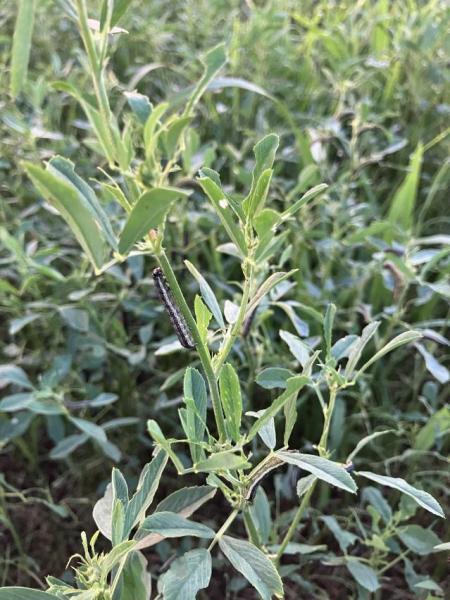As a reminder, fall armyworm does not overwinter in the Midwest. They overwinter in the extreme southern US, and the adults migrate north later in the growing season. It typically takes about 30 days for fall armyworms to complete their life cycle in the summer, and it is possible to have a couple generations in Iowa. Perhaps the good news is that migration to northern states is a death sentence for fall armyworms, as there is no evidence that they migrate back south.
Fall armyworm moths will lay eggs in a mass of 100-200 on light-colored surfaces such as fence posts, poles or tree limbs. The eggs often look moldy or fuzzy because they are covered with grey scales. Eggs hatch within four days and larvae (caterpillars) go through six instars before pupation.
Armyworms tend to move quickly into new areas in large numbers. They can cause significant defoliation. They can cause extensive injury, especially to young plants, and can even destroy the growing point. Consequently, any late summer or fall-seeded grasses or forages can be severely impacted.
The final instar is when they cause the most damage and it may seem like fields were just eaten overnight. In reality the caterpillars have been present longer. Fall armyworm larvae will reach about 1.5 inches in size before pupation.
Identification:
Young larvae are greenish with a dark head. White lines develop along the top of the body along with raised spots and spines as they mature. Older larvae are green to dark brown with stripes along the body and a mottled head. To distinguish fall armyworm from other armyworm species, look for the white, inverted “Y” on the face and four raised bumps in the shape of a square near the end of the abdomen.

Scouting and Management:
Alfalfa and pastures: It is recommended to scout for fall armyworms first thing in the morning or later in the day as this is when they are the most active on plants. A sweep net is the best way to confirm the presence of fall armyworm in pastures or hayfields. The net will pick up larvae that are too small to find other ways. If you find fall armyworm larvae in the sweep net, determine how many caterpillars are present per square foot by looking on plants and in the litter on the soil. If you don’t have a sweep net, check areas that look dead, wilting or drought-stressed, or where birds are congregating. Sometimes, you can find the frass (insect excrement), which are green pellets. The generic threshold is 2 or 3 larvae per square foot. If the threshold is met or exceeded, consider cutting the field, and baling the hay quickly. This removes their food source.

Warm-season annuals: In summer annuals, particularly sorghum and sorghum x sudangrass, fall armyworms will feed on the leaves and grain. Before panicle emergence, fall armyworms will feed in the whorl of the plant making them difficult to find. Generally, you will see the damage before the insects. It can be hard to treat for fall armyworm in the whorl as it is unknown how well the insecticide will reach and kill them.
Soybeans: In soybeans, you can also use a sweep net or a drop cloth to scout for fall armyworms. Ideally you would do this at different spots in the field. Use the usual defoliation thresholds to determine whether treatment is necessary. In reproductive soybeans, the threshold is 20% defoliation across the entire field. There may not be much benefit to an insecticide application after R6 (pod fill), unless fall armyworms are feeding on pods.
Corn: In corn, it is recommended to visit 5 different areas in a field and look at 20 plants in a row at each stop. Fall armyworms may feed on leaves, tassels, or silks, but kernels are the most suitable for growth and development in reproductive corn. Once larvae enter the ear, insecticides are not effective.

Management: If an insecticide application is warranted in any crop, timing is critical for effective larval suppression. Insecticide applications for control of fall armyworm larvae are most effective when the larvae are small (less than ½ inch long) and when made later in the day or first thing in the morning while fall armyworms are actively feeding. Pyrethroids are likely a good option, but other states have noted minimal efficacy in some fields. Use high volume and pressure to create small droplets that ensure contact with the larvae. Always read and follow label directions and don’t forget to check pre-harvest intervals. Continue to scout for migrating larvae until frost.
Source : iastate.edu